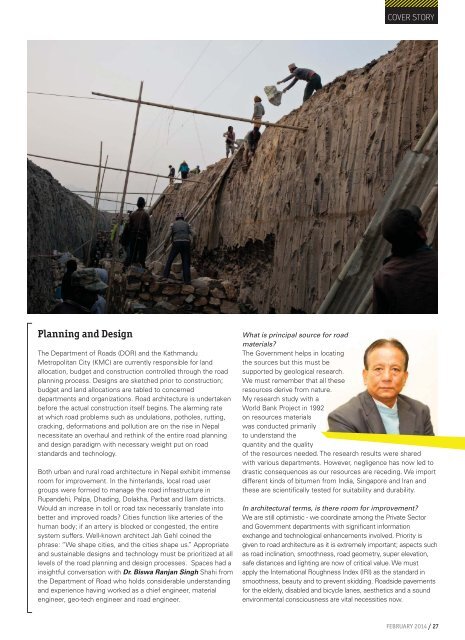2. February 2014
Create successful ePaper yourself
Turn your PDF publications into a flip-book with our unique Google optimized e-Paper software.
COVER STORY<br />
Planning and Design<br />
The Department of Roads (DOR) and the Kathmandu<br />
Metropolitan City (KMC) are currently responsible for land<br />
allocation, budget and construction controlled through the road<br />
planning process. Designs are sketched prior to construction;<br />
budget and land allocations are tabled to concerned<br />
departments and organizations. Road architecture is undertaken<br />
before the actual construction itself begins. The alarming rate<br />
at which road problems such as undulations, potholes, rutting,<br />
cracking, deformations and pollution are on the rise in Nepal<br />
necessitate an overhaul and rethink of the entire road planning<br />
and design paradigm with necessary weight put on road<br />
standards and technology.<br />
Both urban and rural road architecture in Nepal exhibit immense<br />
room for improvement. In the hinterlands, local road user<br />
groups were formed to manage the road infrastructure in<br />
Rupandehi, Palpa, Dhading, Dolakha, Parbat and Ilam districts.<br />
Would an increase in toll or road tax necessarily translate into<br />
better and improved roads? Cities function like arteries of the<br />
human body; if an artery is blocked or congested, the entire<br />
system suffers. Well-known architect Jah Gehl coined the<br />
phrase: “We shape cities, and the cities shape us.” Appropriate<br />
and sustainable designs and technology must be prioritized at all<br />
levels of the road planning and design processes. Spaces had a<br />
insightful conversation with Dr. Biswa Ranjan Singh Shahi from<br />
the Department of Road who holds considerable understanding<br />
and experience having worked as a chief engineer, material<br />
engineer, geo-tech engineer and road engineer.<br />
What is principal source for road<br />
materials?<br />
The Government helps in locating<br />
the sources but this must be<br />
supported by geological research.<br />
We must remember that all these<br />
resources derive from nature.<br />
My research study with a<br />
World Bank Project in 1992<br />
on resources materials<br />
was conducted primarily<br />
to understand the<br />
quantity and the quality<br />
of the resources needed. The research results were shared<br />
with various departments. However, negligence has now led to<br />
drastic consequences as our resources are receding. We import<br />
different kinds of bitumen from India, Singapore and Iran and<br />
these are scientifically tested for suitability and durability.<br />
In architectural terms, is there room for improvement?<br />
We are still optimistic - we coordinate among the Private Sector<br />
and Government departments with significant information<br />
exchange and technological enhancements involved. Priority is<br />
given to road architecture as it is extremely important; aspects such<br />
as road inclination, smoothness, road geometry, super elevation,<br />
safe distances and lighting are now of critical value. We must<br />
apply the International Roughness Index (IRI) as the standard in<br />
smoothness, beauty and to prevent skidding. Roadside pavements<br />
for the elderly, disabled and bicycle lanes, aesthetics and a sound<br />
environmental consciousness are vital necessities now.<br />
FEBRUARY <strong>2014</strong> / 27


















